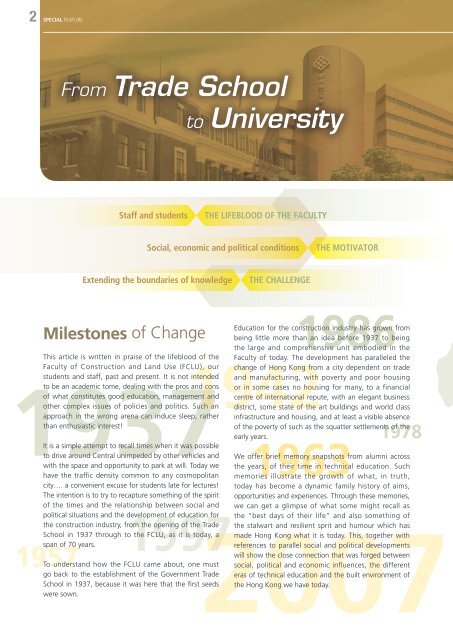Issue No. 4 (August 2007) - The Hong Kong Polytechnic University
Issue No. 4 (August 2007) - The Hong Kong Polytechnic University
Issue No. 4 (August 2007) - The Hong Kong Polytechnic University
You also want an ePaper? Increase the reach of your titles
YUMPU automatically turns print PDFs into web optimized ePapers that Google loves.
SPECIAL FEATURE<br />
From Trade School<br />
to <strong>University</strong><br />
Staff and students<br />
THE LIFEBLOOD OF THE FACULTY<br />
Social, economic and political conditions<br />
THE MOTIVATOR<br />
Extending the boundaries of knowledge<br />
THE CHALLENGE<br />
Milestones of Change<br />
1937<br />
other complex issues of policies and politics. Such an<br />
1997<br />
To understand how the FCLU came about, one must<br />
1957<br />
1986<br />
the large and comprehensive unit embodied in the<br />
1942<br />
approach in the wrong arena can induce sleep, rather<br />
This article is written in praise of the lifeblood of the<br />
Faculty of Construction and Land Use (FCLU), our<br />
students and staff, past and present. It is not intended<br />
to be an academic tome, dealing with the pros and cons<br />
of what constitutes good education, management and<br />
than enthusiastic interest!<br />
It is a simple attempt to recall times when it was possible<br />
to drive around Central unimpeded by other vehicles and<br />
with the space and opportunity to park at will. Today we<br />
have the traffic density common to any cosmopolitan<br />
city…. a convenient excuse for students late for lectures!<br />
<strong>The</strong> intention is to try to recapture something of the spirit<br />
of the times and the relationship between social and<br />
political situations and the development of education for<br />
the construction industry, from the opening of the Trade<br />
School in 1937 through to the FCLU, as it is today, a<br />
span of 70 years.<br />
go back to the establishment of the Government Trade<br />
School in 1937, because it was here that the first seeds<br />
were sown.<br />
Education for the construction industry has grown from<br />
being little more than an idea before 1937 to being<br />
Faculty of today. <strong>The</strong> development has paralleled the<br />
change of <strong>Hong</strong> <strong>Kong</strong> from a city dependent on trade<br />
and manufacturing, with poverty and poor housing<br />
or in some cases no housing for many, to a financial<br />
centre of international repute, with an elegant business<br />
district, some state of the art buildings and world class<br />
infrastructure and housing, and at least a visible absence<br />
of the poverty of such as the squatter settlements of the<br />
early years.<br />
1963 1978<br />
We offer brief memory snapshots from alumni across<br />
the years, of their time in technical education. Such<br />
memories illustrate the growth of what, in truth,<br />
today has become a dynamic family history of aims,<br />
opportunities and experiences. Through these memories,<br />
we can get a glimpse of what some might recall as<br />
the “best days of their life” and also something of<br />
the stalwart and resilient sprit and humour which has<br />
made <strong>Hong</strong> <strong>Kong</strong> what it is today. This, together with<br />
<strong>2007</strong><br />
references to parallel social and political developments<br />
will show the close connection that was forged between<br />
social, political and economic influences, the different<br />
eras of technical education and the built environment of<br />
the <strong>Hong</strong> <strong>Kong</strong> we have today.
















